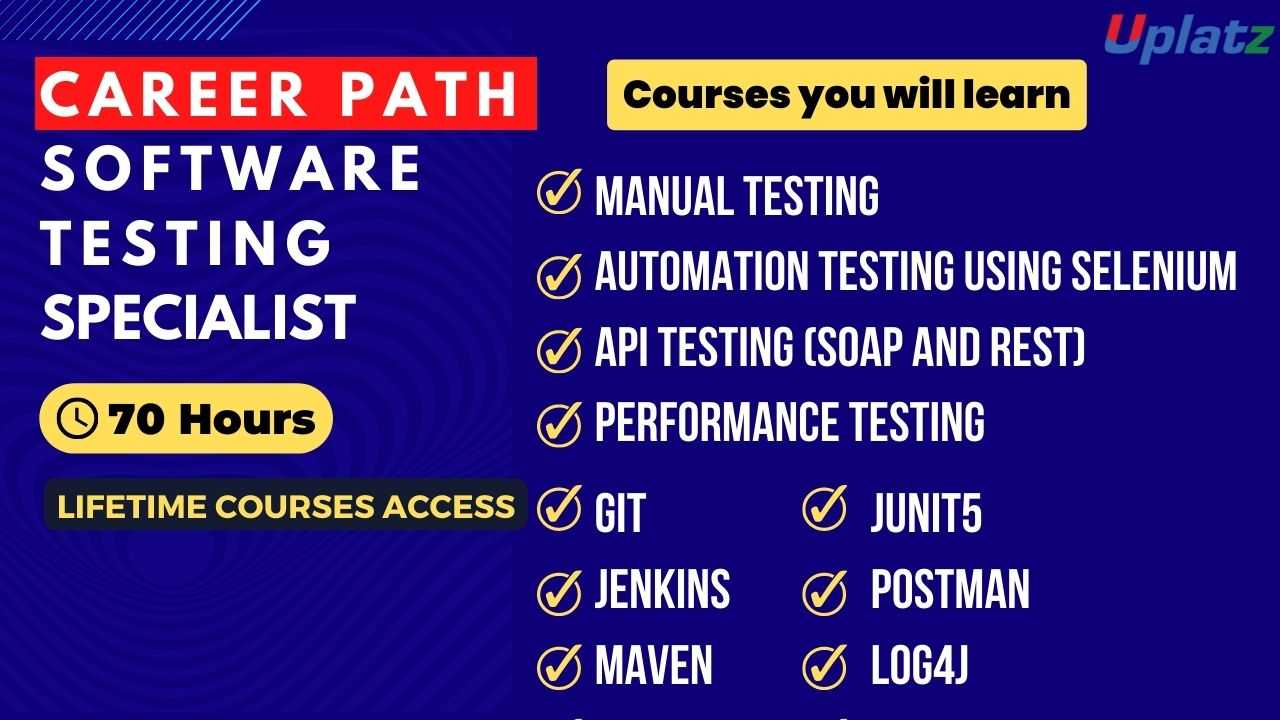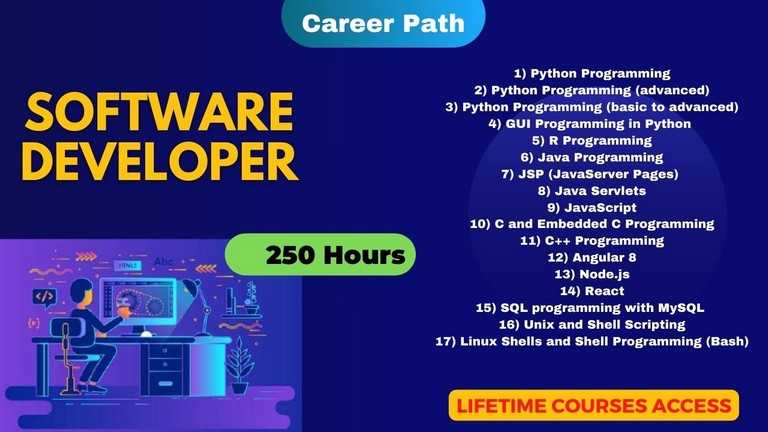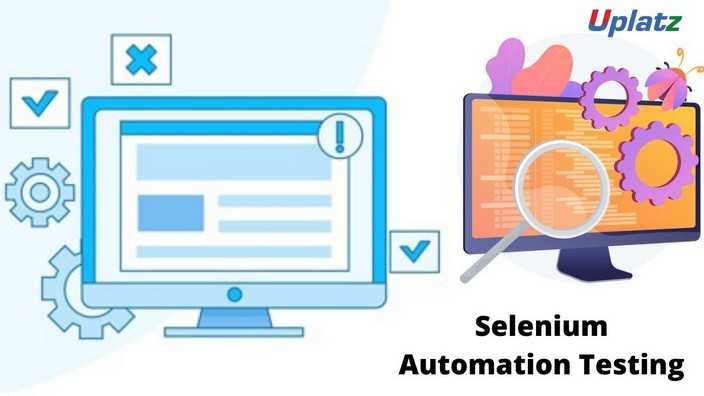Software Performance Engineering and Multicore Programming
Become a System Performance Engineer with command over multicore computing, cache management, hypervisor, memory optimization, parallelization, more..Preview Software Performance Engineering and Multicore Programming course
Price Match Guarantee Full Lifetime Access Access on any Device Technical Support Secure Checkout Course Completion Certificate 84% Started a new career
BUY THIS COURSE (
84% Started a new career
BUY THIS COURSE (GBP 12 GBP 29 )-
 85% Got a pay increase and promotion
85% Got a pay increase and promotion
Students also bought -
-

- Career Path - Software Testing Specialist
- 70 Hours
- GBP 32
- 222 Learners
-

- Career Path - Software Developer
- 250 Hours
- GBP 32
- 3679 Learners
-

- Software Testing (Automation Testing with Selenium)
- 30 Hours
- GBP 12
- 2519 Learners

Software Performance Engineering (SPE) is a systematic, quantitative approach to the cost-effective development of software systems to meet performance requirements. SPE is a software-oriented approach that focuses on architecture, design, and implementation choices. SPE gives you the information you need to build software that meets performance requirements on time and within budget.
The SPE process begins early in the software development life cycle and uses quantitative methods to identify satisfactory designs and to eliminate those that are likely to have unacceptable performance before developers invest significant time in implementation. SPE continues through the detailed design, coding and performance and load testing phases to predict and manage the performance of the evolving software as well as monitor and report actual performance versus specifications and predictions. SPE methods encompass: performance data collection; quantitative performance analysis techniques; prediction strategies; management of uncertainties; data presentation and tracking; performance testing, stress and load testing, model verification and validation; critical success factors; and performance design principles, patterns and antipatterns.
Software Performance engineering is proactive, continuous, and end-to-end application performance testing and monitoring. It allows seamless collaboration between teams, tools, and processes through continuous feedback loops. Here, it’s not just testers who are responsible for quality assurance but developers, performance engineers, product owners, and business analysts as well. Performance engineering is a specialty systems engineering discipline that applies scientific, mathematical, engineering, and measurement concepts, principles, and methods to deliver a system that meets its nonfunctional performance-related requirements.
SPE is language and platform independent. Performance models are constructed from architectural and design-level information. Thus, SPE works with C++, C# and Java as well as with other object-oriented and non-object-oriented languages. The execution behavior of the software will be different with different languages and platforms. Nevertheless, this is reflected in the resource requirement specifications, not the model structure. SPE uses deliberately simple models of software processing with the goal of using the simplest possible model that identifies problems with the system architecture, design, or implementation plans. It is relatively easy to construct and solve these models to determine whether the proposed software is likely to meet performance requirements. As the software development process proceeds, we refine the models to more closely represent the performance of the emerging software and re-evaluate performance.
SPE can be easily integrated into the software development process. It has been used with traditional process models, such as the waterfall model. It works especially well with iterative, incremental processes such as the Unified Process. With an iterative, incremental process, you can use SPE techniques to assess and reduce the risk of performance failure at the project outset, and at each subsequent iteration. Thus, Software performance engineering provides a systematic, cost-effective approach to managing software systems performance. Use of SPE can reduce project costs and eliminate project failures due to performance problems. It can also improve your level of service to customers, reduce business costs, help you use computer resources more efficiently, and improve your competitive position. SPE is sensible, and it works!
Performance engineering focuses on the ability of systems to meet their nonfunctional requirements. A nonfunctional requirement is a requirement that specifies criteria that can be used to judge the operation of a system, rather than specific behaviors. It may address a property the end product must possess, the standards by which it must be created, or the environment in which it must exist. Examples are usability, maintainability, extensibility, scalability, reusability, security, and transportability. Performance engineering activities occur in each phase of the systems development life cycle. It includes defining nonfunctional requirements; assessing alternative architectures; developing test plans, procedures, and scripts to support load and stress testing; conducting benchmarking and prototyping activities; incorporating performance into software development; monitoring production systems; performing root cause analyses; and supporting capacity planning activities. The performance engineering discipline is grounded in expertise in modeling and simulation, measurement techniques, testing, and statistical methods.
Performance engineering methodologies align perfectly with agile processes, taking a "shift-left" approach to address performance much earlier in the development process. For example, component coupling is one of the main causes of performance bottlenecks. When components depend on each other, the overall system performance is limited by the slowest component, the weakest link in the chain. By decoupling system components by design, you can optimize overall system performance.
Uplatz provides deep-dive into Software Performance Engineering (SPE) and Multicore Programming. You will learn key aspects of SPE and how to use multicore programming for software performance optimization and efficiency.
Course/Topic - Software Performance Engineering and Multicore Programming - all lectures
-
Lecture 1 - Software Performance Engineering
-
Lecture 2 - Introduction to Multicore Programming
-
Lecture 3 - Multithreaded Parallelism and Performance Measures
-
Lecture 4 - Analysis of Multithreaded Algorithms
-
Lecture 5 - Issues in Parallelization
-
Lecture 6 - Synchronizing without Locks and Concurrent Data Structures
-
Lecture 7 - Cache Complexity
-
Lecture 8 - Around Montgomery Trick
-
Lecture 9 - Space vs Time and Cache vs Memory
-
Lecture 10 - Experience in Coding High Performance Numerical Libraries
-
Lecture 11 - FFT based Polynomial Arithmetic on Multicore
-
Lecture 12 - Parallel Programming for Many Core Architectures
-
Lecture 13 - Memory Hierarchy Optimization - part 1
-
Lecture 14 - Memory Hierarchy Optimization - part 2
-
Lecture 15 - Writing Correct Programs
-
Lecture 16 - Floating Point and Linear Algebra
-
Lecture 17 - Applications
-
Lecture 18 - Dynamic Scheduling and Sorting
-
Lecture 19 - Virtual Machines
-
Lecture 20 - Hypervisor Architecture
-
Lecture 21 - Multicore Computing
-
Lecture 22 - Multicore Programming - part 1
-
Lecture 23 - Multicore Programming - part 2
-
Lecture 24 - Multicore Programming - part 3
-
Lecture 25 - Multicore Programming - part 4
-
Lecture 26 - Multicore Programming - part 5
-
Software Performance Engineering
-
Introduction to Multicore Programming
-
Multithreaded parallelism and Performance Measures
-
Analysis of Multithreaded Algorithms
-
Issues in Parallelization
-
Synchronizing without locks and concurrent data structures
-
Cache Complexity
-
Montgomery Trick
-
Space Vs Time Cache Vs Memory
-
Experience in coding high performance numeric libraries
-
FFT Based Polynomial Arithmetic on Multicore
-
Parallel Programming for Many high-performance Architectures
-
Memory Hierarchy Optimization-I
-
Memory Hierarchy Optimization-II
-
Writing Correct Programs
-
Floating Point
-
Applications
-
Dynamic Scheduling Sorting
-
Virtual Machines
-
Hypervisor
-
Multicore Computing
-
Multicore Programming-I
-
Multicore Programming-II
-
Multicore Programming-III
-
Multicore Programming-IV
-
Multicore Programming-V
1. What is Software Engineering?
Software engineering is defined as the function of the systematic, disciplined, quantified approach to the development, operations, and maintenance of software.
2. What is Tableau Construction
Consider the tableau-construction problem from Lecture 8. The problem involves filling an N × N
tableau, where each entry of the tableau is calculated as a function of some of its neighbors. To
be specific, the equation to fill an element of the tableau would take the form
A[i][j] = f(A[i − 1][j − 1], A[i][j − 1], A[i − 1][j])
where f is an arbitrary function.
3. Define Framework
A framework is the Code Skeleton that can be fleshed out with particular classes or functionality and designed to address the specific problem at hand.
4. What is the difference between scalability and performance in software testing?
“Performance is an indication of the responsiveness of a system to execute any action within a given time interval, while scalability is the ability of a system either to handle increases in load without impact on performance or for the available resources to be readily increased.
5. Why adopt a performance engineering mindset?
Only by adopting a performance engineering mindset can you ensure rapid application delivery. Performance engineering methodologies align perfectly with agile processes, taking a "shift-left" approach to address performance much earlier in the development process.
6. What is Performance Engineering?
Software Performance Engineering is the systematic approach of constructing the software that meets the performance objectives.
7. Does your software performance meet the requirements of today’s World?
Your software performance needs to meet the performance requirements of today’s world, regardless of when they were created. Sometimes, trying to keep up can fall by the wayside and reveal many, many problems.
8. What are the various phases of SDLC?
The following are the most common phases of SDLC:
Requirement Analysis, Design, Coding, Testing, Maintenance.
9. What are performance bottlenecks and how do you avoid them?
Bottlenecking is a common concept in software and website testing, so interviewers may ask about how you address them during the testing process. Describe the different types of performance bottlenecks to show your expertise, then explain a basic strategy for preventing them to show your knowledge of system functions.
10. What do you mean by concurrent user hits in case of load test?
There may arise a situation when more than one user will hit on the same event of the application during load testing and this situation is referred to as concurrent user hit. There is the addition of these concurrency points. This is done so that the virtual multiple users would be able to work in a single event of application.
11. Why do the users need to do performance testing?
Performance testing is a very good platform because of the following reasons:
1) It is used to verify the application's response time for the user's numbers which is intended.
2) It also provides the capacity of load testing of the application to its maximum level.
3) It also provided the facility for managing the transaction quantity.
4) Under both the unexpected and expected load of the user, application stability is provided.
5) It also makes sure that response time is provided to the users properly during production.
12. Mention the reasons why load testing in the automated form is performed?
There were certain disadvantages of Manual load testing which are described below.
1) There was no accuracy regarding the measurements of the application's performance.
2) It was also very difficult to perform synchronization among users.
3) Also, there is a need for the number of users in real-time in case of performance testing.
4) Manual testing will cause an increment in the cost of infrastructure.
Due to these above-mentioned disadvantages of load testing in the form of manual procedures, automated testing is performed.
13. List the activities which are performed during performance testing?
The activities are:
a) Creation of user scenarios
b) Distribution of users
c) Scripting
d) Application dry run
e) Implementation of the load test, the collection of results, and then analysis of results
14. What does a System Engineering Model accomplish?
System Engineering Model accomplishes the following:
a) Define Processes that serve needs of view
b) Represent behavior of process and assumption
c) Explicitly define Exogenous and Endogenous Input
d) It represents all Linkages that enable an engineer to understand aspect better
15. Define Framework.
A framework is the Code Skeleton that can be fleshed out with particular classes or functionality and designed to address the specific problem at hand.
16. What are the characteristics of the software?
Characteristics of the software are:
a) Software is engineered, not manufactured.
b) Software does not wear out.
c) Most software is custom-built rather than being assembled from components.
17. Define Software Prototyping.
Software prototyping is represented as rapid software development for validating the requirements.
18. What is Coupling?
Coupling is the degree of interdependence between the modules. Good software has low levels of coupling.
19. Explain the concept of Modularization.
Modularization is used to divide software into multiple components or modules. Each module is worked upon by an independent development and testing team. The final result would be to combine multiple modules into a single working component.
20. What is Software Configuration Management?
Software configuration management is the process of tracking and controlling the changes that occur during the software development lifecycle. Any change made during software development has to be tracked through a well-defined and controlled process.
Configuration management ensures that any changes made during software development are being controlled through a well-defined process.
21. What are performance bottlenecks and how do you avoid them?
Bottlenecking is a common concept in software and website testing, so interviewers may ask about how you address them during the testing process. Describe the different types of performance bottlenecks to show your expertise, then explain a basic strategy for preventing them to show your knowledge of system functions.
22. What is performance testing and its main purpose?
Interviewers ask candidates to discuss the basics of performance testing to determine their fundamental understanding of the field and understanding of the role. Briefly define performance testing in your own words, then focus on its relation to the job for which you're interviewing. You can discuss the long-term impact of performance testing to show that you appreciate how your work influences your future employer.
23. What do you mean by concurrent user hits in case of load test?
There may arise a situation when more than one user will hit on the same event of the application during load testing and this situation is referred to as concurrent user hit. There is the addition of these concurrency points. This is done so that the virtual multiple users would be able to work in a single event of application.
24. Why do the users need to do performance testing?
Performance testing is a very good platform because of the following reasons.
a) It is used to verify the application's response time for the user's numbers which is intended.
b) It also provides the capacity of load testing of the application to its maximum level.
c) It also provided the facility for managing the transaction quantity.
d) Under both the unexpected and expected load of the user, application stability is provided.
e) It also makes sure that response time is provided to the users properly during production.
25. List the activities which are performed during performance testing?
The activities are:
a) Creation of user scenarios
b) Distribution of users
c) Scripting
d) Application dry run
e) Implementation of the load test, the collection of results, and then analysis of results
26. What is JMeter?
It is another java tool that is used for performance load testing. It can analyze and measure the performance of a variety of services with a focus on a web application. Its architecture is based on plugins. The last version of Apache JMeter is 3.3. we can also run JMeter with Jenkins.









